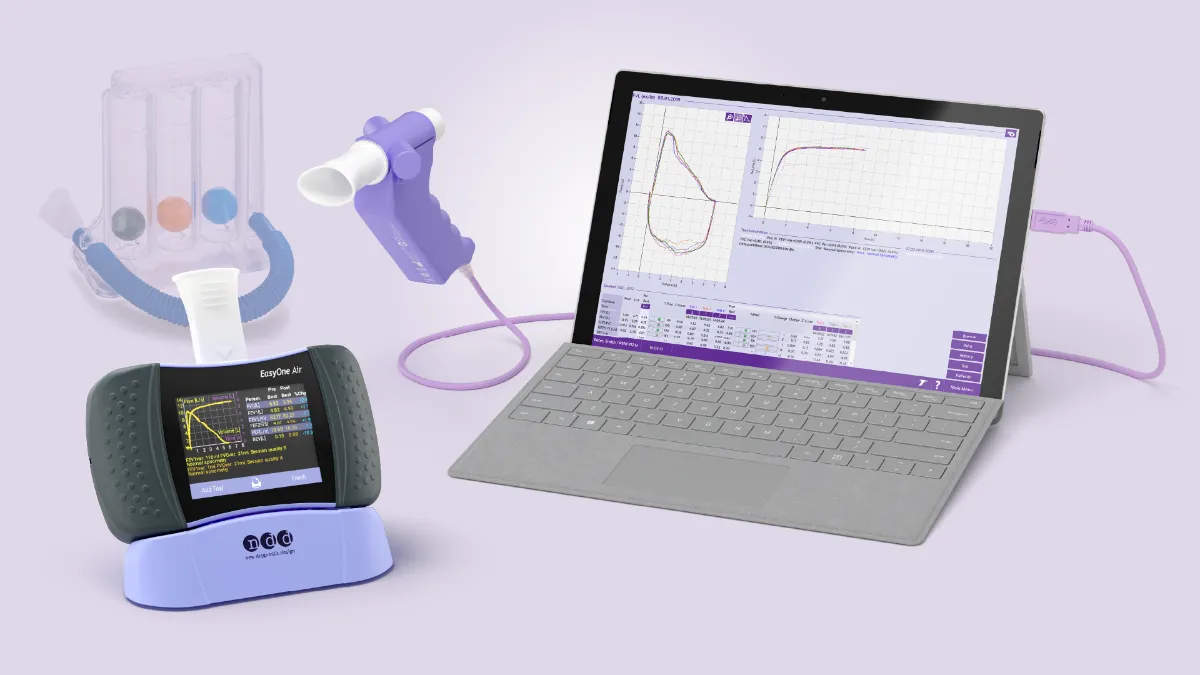Unlocking the power of spirometry

Supporting respiratory health can have a direct impact on overall health and well-being. Patients with healthy lungs can be more physically active, which helps to promote better sleep and can also lead to enhanced cognitive function. Maintaining good respiratory health across the lifespan, however, can be difficult, especially when patients are current or former smokers with COPD, have asthma, cystic fibrosis, or other chronic lung disease, or work in occupations that can compromise lung health.
Spirometry testing is the most common pulmonary function test. It measures how much air a patient can breathe in and out of their lungs and how fast they can do it. It’s not only the best way to diagnose lung disease, but it can also help monitor lung function over time to see if it is improving or worsening and to guide medication management.
Spirometry testing and early detection of respiratory conditions #
The early diagnosis of respiratory diseases allows opportunities to implement interventions in the early stages of the disease and may help to decrease the rate of decline in lung function. By identifying three primary parameters generated with spirometry, providers can deduce whether a patient suffers from restrictive or obstructive lung disease.
These three parameters include:
- Forced vital capacity (FVC)-Measures how much air a person can exhale during a forced breath.
- Forced expiratory volume (FEV1)-The amount of air exhaled during the first second of a forced breath.
- The ratio of FEV1 to FVC (FEV1/FVC)-The proportion of a patient’s vital capacity they can exhale in the first second to the total forced vital capacity.
Once the three parameters are established, providers can use the information to determine whether the pattern is obstructive, restrictive, or normal.
Obstructive Disease
- Reduced FEV1
- Normal (or reduced) VC
- Normal (or reduced) FVC
- Reduced FEV1/FVC ratio
Restrictive Disease
- Reduced FVC
- Normal to high FEV1/FVC ratio
Monitoring respiratory conditions with spirometry #
Spirometry isn’t only useful for diagnosing lung disease; it’s also an essential tool that can provide valuable information to develop personalized treatment plans for patients over time.
For instance, asthma management1 requires spirometry to measure lung function over time objectively.
- At initial assessment
- After treatment is initiated and symptoms have stabilized
- During times of progressive or prolonged asthma exacerbations
- At least every 1-2 years and more frequently depending on therapy response
Spirometry is also an objective tool for monitoring the disease progression in COPD, helping determine prognosis, and estimating long-term survival based on the severity of symptoms and number of exacerbations. As FEV1 decreases, the chance of mortality increases.
According to the 2024 Gold Report’s Global Strategy for Prevention, Diagnosis, and Management of COPD, spirometry’s role in COPD includes the following:
- Diagnosis
- Assessment of the severity of airflow obstruction (for prognosis)
- Follow-up assessment
The follow-up assessment is where providers can make further therapeutic decisions. For instance, pharmacological interventions may be warranted if there is a discrepancy between spirometry results and the level of symptoms.
Non-pharmacological interventions could include smoking cessation, pulmonary rehabilitation, oxygen therapy, or bronchoscopic interventional treatments if warranted.
Follow-up assessments also help identify rapid decline that could require non-invasive ventilation or palliative approaches as symptoms continue to advance.2
Key spirometry benefits #
Clinicians who use spirometry machines in their practice to routinely assess their patients with suspected respiratory disease derive these key benefits:
- Early detection of respiratory conditions
- Effective monitoring of chronic lung disease
- Personalized treatment plans and better disease management
Early and accurate diagnosis of respiratory disease is essential to proper management and better patient outcomes. Since general practitioners are most of these patients’ first point of contact, utilizing spirometry should be the first step in getting them on the path to an appropriate and long-lasting treatment plan.
Are you looking for the perfect spirometry machine for your practice? Explore the EasyOne spirometers for convenient, in-office diagnosis and management of COPD, asthma, and other lung diseases.
asthsumm.pdf. Accessed November 5, 2023. https://www.nhlbi.nih.gov/sites/default/files/media/docs/asthsumm.pdf ↩︎
2024 GOLD Report. Global Initiative for Chronic Obstructive Lung Disease - GOLD. Published 2023. https://goldcopd.org/2024-gold-report/ ↩︎
Written by

Allison DeMajistre
BSN, RN, CCRN
Allison DeMajistre is a freelance medical writer with a decade of clinical experience as a critical care registered nurse. She writes about cardiology, pulmonology, and several other medical topics. She strives to simplify complex medical information for patients and to write insightful and informative articles for health care professionals.








